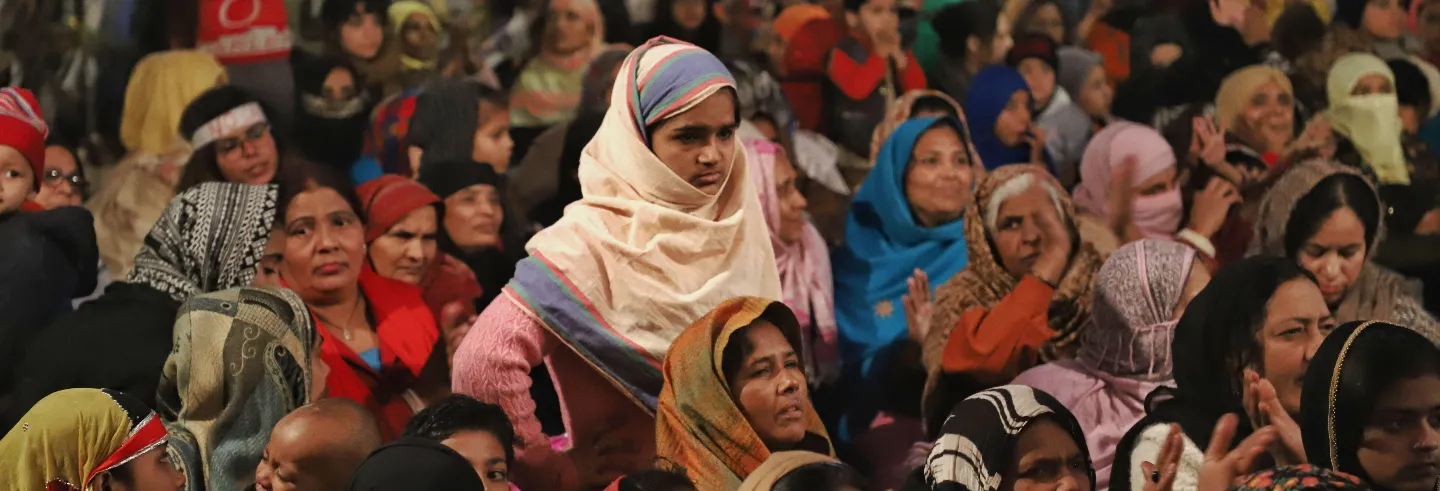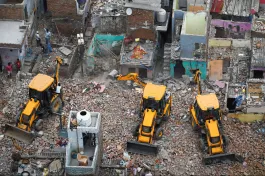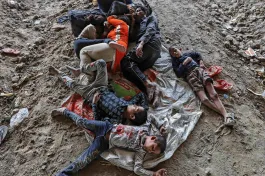During the protests triggered by the passage of the Citizenship Amendment Act 2019 (CAA), the Indian public sphere was rife with exclamations at Muslim women ‘coming out of their homes’ into the streets. The protesters displayed a grim persistence against state repression, targeted violence, vicious propaganda by the right wing, and the bitter cold. The protests continued in public spaces across India for weeks without any response from the Union Government on its demands.
All of this was surprising to observers because Muslim women are deemed to lead sequestered lives. Indeed, when the protesters had to suspend the sit-ins due to the Covid-19 lockdown restrictions in March 2020 they were deemed to have ‘receded into their homes’.
The absence of street protests has never been a reason anywhere in the world to assume a lack of political consciousness amongst women. But Muslim women have always been held against standards different from other women.
Mainstream biases
There is an enduring curiosity about Muslims in India which seems to be satiated only by writings that confirm preconceived biases. This perhaps explains the absurd surprise expressed upon encountering Muslim women’s political expression in the anti-CAA protests which challenged prevailing wisdom perpetuated by tired tropes in the said literature.
However, the reality of Muslim women’s activism lies somewhere between the valorisation of their street protests and their imagined (intellectual and physical) confinement within households. Their challenge to the mainstream public sphere and dominant frames of what should women’s activism concern itself with can be construed to form Muslim women’s counterpublics.
Yet, opportunities for Muslim women activists to compare notes on their experiences with other women activists and make them truly ‘shared’ are rare.
Muslim women, especially younger activists, express deep disappointment with public figures recognised for their Muslimness for failing to advocate for Muslims without riders and with empathy.
Women’s rights advocates amongst Muslims have long had to grapple with pervasive majoritarian biases in India, including in the wider feminist movement. Even those who identified as progressives often unwittingly internalised majoritarian biases and reproduced them uncritically.
Women from no other community are framed in similar terms in the formal academic, legal, or administrative discourses – namely, only as victims or as vessels of indoctrination. The idea of Muslim women constituting an unthinking docile crowd—who are easily mobilised by Muslim men and instrumentalised into making demands they do not understand—was floated and strengthened in references to the Shah Bano case. Muslim women’s participation in the protests around the case was seen as a result of being indoctrinated by Muslim men, rather than as an articulation of the importance the former accorded to the protection of minority rights.
A shrewd campaign
The misconception that an average Muslim woman has no understanding of politics was especially evident in progressive allies’ repeated remarks about the secular constitutional iconography of Shaheen Bagh sit-in protests. Reminiscent of the tendency to frame all references to Muslims in communal terms, Muslim women were assumed to be communal until they proved themselves secular by ‘utilising the constitutional frame’.
Like any other social movements (especially those opposing a hostile regime on the streets), the anti-CAA protesters made strategic decisions about the selection of frames that best expressed their cause and could mobilise wider support for it.
[I]t should not come as a surprise that Muslim women do not share the dominant framing of what ought to be “women’s issues”. For them, the segregation of Muslim issues from Muslim women’s issues does not make sense.
Women’s movements across the world are often a political construct cobbled together from their writings, private struggles and dispersed socio-legal advocacy. This is a consequence of women’s care roles in communities obstructing participation in organised mass protests. In this light, the anti-CAA protests were not an event in which Muslim women got politically educated, but an outcome of their political judgement.
Muslim women protesters were proven right in their calculation about what was at stake in the CAA. They successfully signalled how hard they were ready to fight. These calculations of political costs and risks required understanding the nature of the ruling regime and its likely responses.
An uphill battle
Asserting Muslim women’s rights has been difficult in post-Partition India because of the terms by which Muslim women’s speech is recognised in the Indian public sphere.
They are heard only if the issue at hand is amenable to raising controversies about Islam. Often, the discussion is hijacked by the Hindu right wing. Muslim women’s rights are curtailed in the guise of ‘saving’ them from Islamic fundamentalism, as in the case of Muslim girls students excluded from public schools in the name of hijab. Or these issues are used as an excuse to criminalise and target Muslim men, as in the case of triple talaq.
Judicial attitudes towards Muslim issues are read by Muslim women as downright hostile and communal and not just apathetic.
This conundrum has disrupted Muslim women’s quest for equal rights within the community. Any assertion of feminism or women’s rights within an Islamic framework is demobilised by majoritarian threats.
Muslim women, especially younger activists, express deep disappointment with public figures recognised for their Muslimness for failing to advocate for Muslims without riders and with empathy. They further complain that these ‘representative’ voices are often quick to lecture Muslims on their actual and alleged shortcomings in the wider public sphere in India.
Political trauma and community care work
With the current regime, all avenues to advocate for social provisioning have been closed to Muslims. Political dialogue is virtually non-existent, while targeted mass and individualised anti-Muslim violence is a constant possibility and frequent reality. Muslims have been electorally disenfranchised by most political parties who refuse to address them or their concerns. They have been traumatised by administrative ‘bulldozer’ violence.
In such a situation, it should not come as a surprise that Muslim women do not share the dominant framing of what ought to be “women’s issues”. For them, the segregation of Muslim issues from Muslim women’s issues does not make sense. They reject the denial of Muslim subjectivity to them just as a Dalit woman would reject the denial of caste subjectivity.
It is an aphorism to say that Muslim women experience more discrimination than similar-gendered persons with other identities. Many have told me that they are made to feel as if their very presence as a visibly Muslim person in public and shared spaces is a threat.
The everyday hostility expressed by neighbours, colleagues and friends intentionally or unwittingly only triggers further trauma in a psyche ravaged by a society saturated with hate speech calling for rape, killing, and pillaging.
Even those who are sympathetic to the Muslim position and have a secular outlook ‘prefer’ Muslim women to mirror their own perspectives and agree to be patronised ‘pleasantly’. In workplaces and university spaces, a vocal Muslim woman is labelled aggressive and intimidating. Any display of autonomy such as disagreeing with the dominant framing of issues and strategies is met with disapproval and microaggression. Even as they notice rudeness Muslim women are likely to ignore it because they wish to avoid trouble but also because they do not wish to be seen as creating trouble.
The experiences of Muslim women are not seen if they stay quiet and are doubted if they express them. Speech would be easy if it did not involve validation or refutation. But the more disturbing feature is that the older Muslim women who command respect and authority in civil society blunt their voices for the fear of alarming and alienating their friends. On the other hand, young Muslim women with sharp voices find themselves targeted by organised communal enterprises and disparate Islamophobic entrepreneurs to defame them and paralyse their successful articulation.
Such hostile responses to Muslim women’s expression can be unnerving and alienating. The everyday hostility expressed by neighbours, colleagues and friends intentionally or unwittingly only triggers further trauma in a psyche ravaged by a society saturated with hate speech calling for rape, killing, and pillaging.
Keeping faith
Beyond this dynamic of microaggression, criminal intimidation, and mob violence, an acute feeling of abjectness is fed by frustration regarding procedural and substantive justice. Judicial attitudes towards Muslim issues are read by Muslim women as downright hostile and communal and not just apathetic.
They recognise that botched investigations, enquiry reports in cold storage, inordinate judicial delays and callous disregard for the word of law mark the Indian state’s response to mass and mob violence against Muslims. An overriding worry in the women’s minds is that while insisting on due process and accountability is the only way forward, that path has been proven to be circuitous, tiring, and not leading to justice.
In political discussions, Muslim women speak of sabr (fortitude) when treading the path of justice and when opposing zulm (oppression).
Nevertheless, many Muslim women keenly followed the judicial trajectory of the hijab ban originating in Udupi, Karnataka. Those with access to the internet watched the live court proceedings. The line of questioning by the judges, their remarks and non-verbal cues during the proceedings were used to read judicial attitudes. Women organised meetings to discuss the legal and theological issues involved, taking care to invite women with differing positions. The judgments were widely circulated and read. Study groups were organised to discuss them threadbare and discuss legal strategies going forward. Even less-educated middle-class housewives discussed the case in family and social gatherings – trying to understand or explain the complexities and challenges to each other.
Instead of getting immobilised by political trauma and anxiety, most Muslim women have responded by taking on larger social responsibility. This is often framed by Muslim women activists as an attempt to exercise citizenship and care work beyond the limits of the immediate family. While they cite spiritual and religious motivations to perform acts of piety, many also frame charity as a political response.
“Trust in Allah, but tie your camel first” was a hadith vigorously discussed in common Muslim households during the Covid-19 pandemic. These discussions led to a more sophisticated understanding of the Islamic principle of predestination – which is often confused in South Asian Muslim cultures with fatalism – as one that includes the exercise of free will. Muslim women activists often express that they do whatever is in their power to do and leave the rest to Allah.
The particular form of Muslim women’s activism produced by the threat of loss of citizenship stands against the backdrop of a long history of communal violence and discrimination.
These gestures emphasise a proactive approach to community action when faced with authoritarianism. Muslim women who are social-media influencers consciously call out injustices and critique disabling of voices, figures and institutions that come out in support of justice. Their wit, humour, cutting satire, outrage and also their despair routinely sears the consciousness of anyone who remotely cares. Many run micro-crowdfunding efforts to raise tuition fees, medical expenses, rent and repair costs for houses, and other basics for a dignified life.
In political discussions, Muslim women speak of sabr (fortitude) when treading the path of justice and when opposing zulm (oppression). For them, to lose hope in the possibility of justice is decidedly un-Islamic.
Coda
In the face of an extremely hostile regime, many Muslim women activists confess that talk of protecting minority rights feels like empty rhetoric. They find themselves having to deal with the daily dilemma of choosing an attitude of fortitude and taking up a mode of activism that appears feasible given their limited financial and political resources. What they choose often is exhausting personally and financially, taking up more responsibilities than necessary and expressing solidarity across class, caste and other social divides.
The particular form of Muslim women’s activism produced by the threat of loss of citizenship stands against the backdrop of a long history of communal violence and discrimination. It has to contend with the vulnerability of Muslim men to state violence, constrained livelihoods, and the spectre of summary demolition of houses. Care work for their families is extended to care work for the community too.
The figure of a Muslim mother or wife now includes a requirement for political acumen and courage, in addition to care and piety. Not only do they have to raise strong daughters but also protect sons and husbands when needed. The added precarity of Muslim domesticity disrupts the established gendered norms of socialisation and performance of roles. Patriarchal barriers to women’s education and mobility, familial control, and domestic violence have not evaporated, but they are certainly challenged by Muslim women’s response to political hostility.
Ghazala Jamil is an assistant professor at the Centre for the Study of Law and Governance, Jawaharlal Nehru University. Her most recent book is Women in Social Change (Sage 2021).









